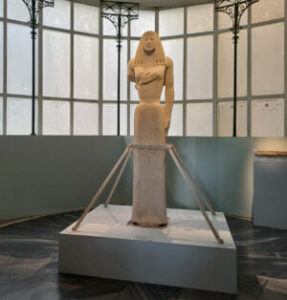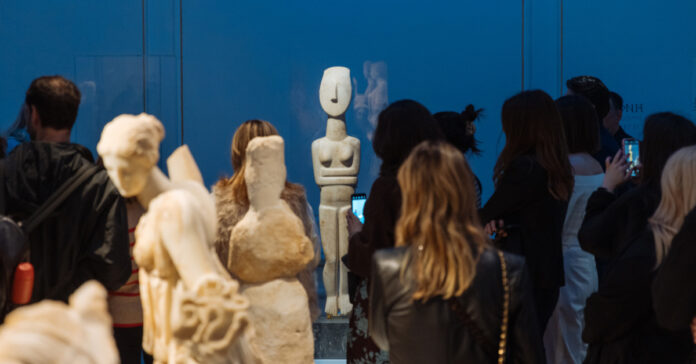Santorini island news
The Renovated Archaeological Museum of Thera Opens Its Doors Once Again
After being closed for several years due to extensive renovation works, the Archaeological Museum of Thera in Fira is reopening to the public. From Saturday, June 21st, visitors will once again be able to explore its remarkable collection in a renewed and enhanced setting.
At the heart of the new exhibition is the famous Kori of Thera, a rare masterpiece of early Greek sculpture dating to the 7th century BC. This monumental marble statue was unexpectedly discovered in November 2000, during a rescue excavation at the cemetery of ancient Thera, in the southeastern area of Sellada, by the late Santorinian archaeologist Charalambos Sigalas.
The Kore, carved from white Naxian marble and standing at an impressive 2.48 meters, is almost completely intact. Only the tip of her nose and the forearm of her bent right arm, which rests on her chest, are missing. She is one of the very few surviving examples of large-scale, freestanding stone sculptures from early Greek art, embodying the archetypal Kori (maiden) form of the Archaic period.

Dressed in a long Doric peplos and now mounted on a new base, without any metal supports, the Kore of Thera takes her rightful place among the “Cycladic women”, symbolic female figures from islands across the Aegean that have gathered around her to celebrate her return home.
The statue, which was recently exhibited at the Museum of Cycladic Art in Athens, now returns to Santorini as the central figure in the reopening of the Archaeological Museum of Thera.
The museum’s reopening is accompanied by the major exhibition “Kykladitisses: Untold Stories of Women in the Cyclades”, organized by the Museum of Cycladic Art and the Hellenic Ministry of Culture, through the Ephorate of Antiquities of the Cyclades. The exhibition will run until October 31, 2025.
The exhibition offers a rare look at the lives of women in the Cyclades – from prehistory to the 19th century – through 180 unique artifacts from nearly every Cycladic island: Amorgos, Andros, Delos, Thera, Ios, Kea, Kythnos, Milos, Mykonos, Naxos, Paros, Serifos, Sikinos, Sifnos, Syros, Tinos, and Folegandros.
The Kykladitises exhibition explores the roles of women in Cycladic island societies over the centuries, as goddesses, mothers, priestesses, courtesans, merchants, warriors, intellectuals, mourners, witches, and migrants. These stories are told through statues, inscriptions, jewelry, frescoes, mosaics, and more often reflecting how women were seen through the eyes of the men of their time.
The goal is to shed light on little-known or “unspoken” stories of female presence and power, and how these were shaped by life on the islands.
Among the highlights are three monumental pieces:
-
-
The Kori of Thera
-
The iconic fresco “Women in the Adyton” from Akrotiri (nearly 4 meters in length)
-
A Hellenistic statue of Artemis Elaphivolos from Delos
-
The exhibition is curated by Dr. Dimitris Athanasoulis, Director of the Ephorate of Antiquities of the Cyclades, Dr. Panagiotis Iossif, Professor at Radboud University in the Netherlands, and Dr. Ioannis Fappas, Assistant Professor of Prehistoric Archaeology at the Aristotle University of Thessaloniki.

The official opening of the Archaeological Museum of Thera and the Kykladitisses exhibition will take place on Friday, June 20 at 19:00, by invitation only.
From Saturday, June 21, the museum will be open to the public daily except Mondays, with the following schedule:
-
Tuesday to Friday and Sunday: 08:30–15:30
-
Saturday: 09:00–21:00
Admission: €10
This long-awaited reopening marks a significant cultural moment for Santorini, inviting visitors to rediscover the island’s past through the powerful, often hidden stories of the women who shaped it.

